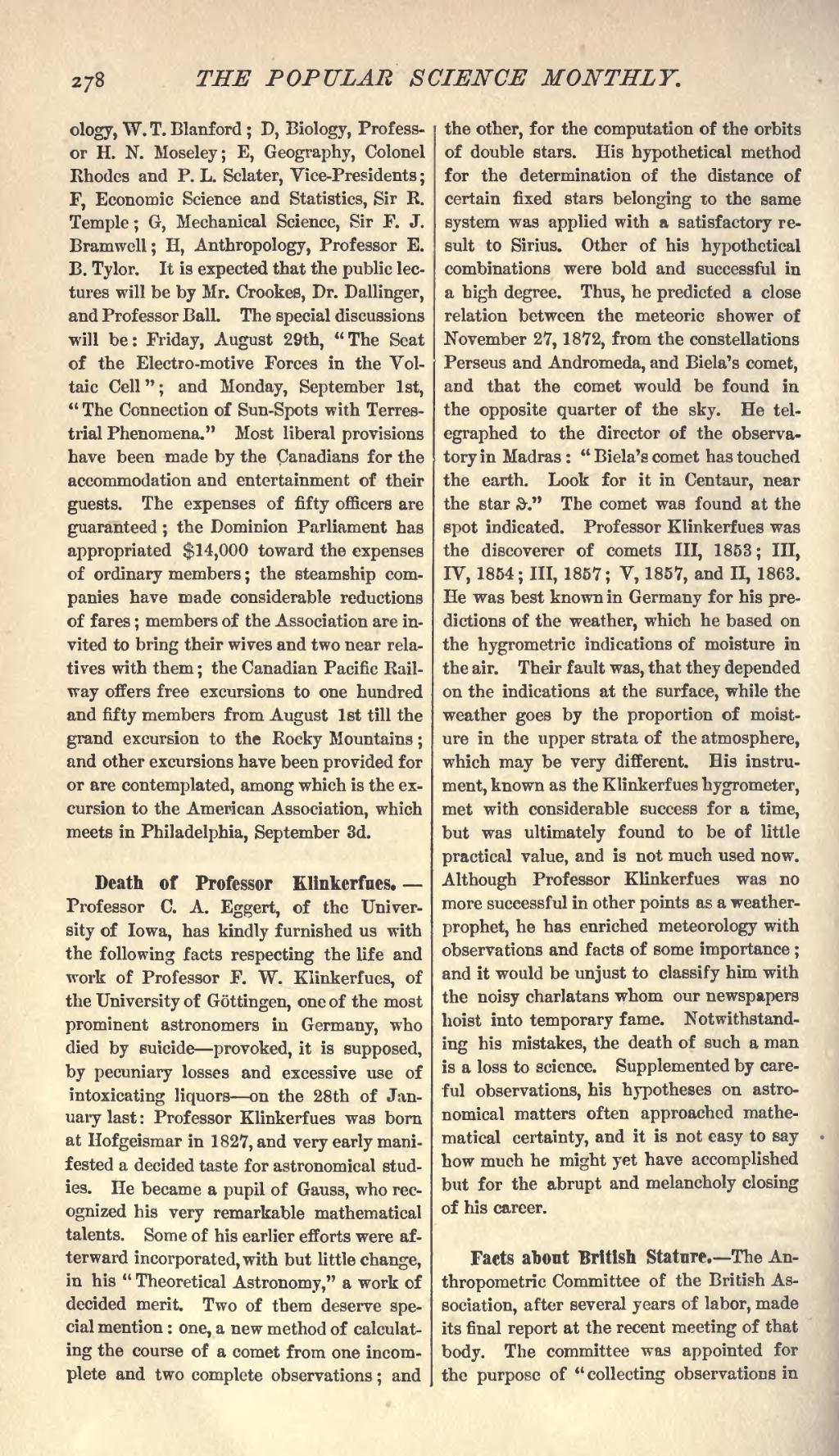ology, W. T. Blanford; D, Biology, Professor H. N. Moseley; E, Geography, Colonel Rhodes and P. L. Sclater, Vice-Presidents; F, Economic Science and Statistics, Sir R. Temple; G, Mechanical Science, Sir F. J. Bramwell; H, Anthropology, Professor E. B. Tylor. It is expected that the public lectures will be by Mr. Crookes, Dr. Dallinger, and Professor Ball. The special discussions will be: Friday, August 29th, "The Seat of the Electro-motive Forces in the Voltaic Cell"; and Monday, September 1st, "The Connection of Sun-Spots with Terrestrial Phenomena." Most liberal provisions have been made by the Canadians for the accommodation and entertainment of their guests. The expenses of fifty officers are guaranteed; the Dominion Parliament has appropriated $14,000 toward the expenses of ordinary members; the steamship companies have made considerable reductions of fares; members of the Association are invited to bring their wives and two near relatives with them; the Canadian Pacific Railway offers free excursions to one hundred and fifty members from August 1st till the grand excursion to the Rocky Mountains; and other excursions have been provided for or are contemplated, among which is the excursion to the American Association, which meets in Philadelphia, September 3d.
Death of Professor Klinkerfues.—Professor C. A. Eggert, of the University of Iowa, has kindly furnished us with the following facts respecting the life and work of Professor F. W. Klinkerfues, of the University of Göttingen, one of the most prominent astronomers in Germany, who died by suicide—provoked, it is supposed, by pecuniary losses and excessive use of intoxicating liquors—on the 28th of January last: Professor Klinkerfues was born at Hofgeismar in 1827, and very early manifested a decided taste for astronomical studies. He became a pupil of Gauss, who recognized his very remarkable mathematical talents. Some of his earlier efforts were afterward incorporated, with but little change, in his "Theoretical Astronomy," a work of decided merit. Two of them deserve special mention: one, a new method of calculating the course of a comet from one incomplete and two complete observations; and the other, for the computation of the orbits of double stars. His hypothetical method for the determination of the distance of certain fixed stars belonging to the same system was applied with a satisfactory result to Sirius. Other of his hypothetical combinations were bold and successful in a high degree. Thus, he predicted a close relation between the meteoric shower of November 27, 1872, from the constellations Perseus and Andromeda, and Biela's comet, and that the comet would be found in the opposite quarter of the sky. He telegraphed to the director of the observatory in Madras: "Biela's comet has touched the earth. Look for it in Centaur, near the star ϑ." The comet was found at the spot indicated. Professor Klinkerfues was the discoverer of comets III, 1853; III, IV, 1854; III, 1857; V, 1857, and II, 1863. He was best known in Germany for his predictions of the weather, which he based on the hygrometric indications of moisture in the air. Their fault was, that they depended on the indications at the surface, while the weather goes by the proportion of moisture in the upper strata of the atmosphere, which may be very different. His instrument, known as the Klinkerfues hygrometer, met with considerable success for a time, but was ultimately found to be of little practical value, and is not much used now. Although Professor Klinkerfues was no more successful in other points as a weather-prophet, he has enriched meteorology with observations and facts of some importance; and it would be unjust to classify him with the noisy charlatans whom our newspapers hoist into temporary fame. Notwithstanding his mistakes, the death of such a man is a loss to science. Supplemented by careful observations, his hypotheses on astronomical matters often approached mathematical certainty, and it is not easy to say how much he might yet have accomplished but for the abrupt and melancholy closing of his career.
Facts about British Stature.—The Anthropometric Committee of the British Association, after several years of labor, made its final report at the recent meeting of that body. The committee was appointed for the purpose of "collecting observations in
